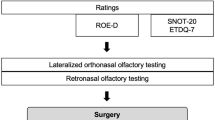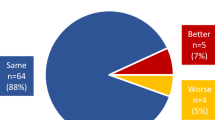Abstract
Nasal surgery is frequently performed. Predictors of surgical outcome in terms of chemosensory function are not clear. A total of 64 patients were included in this prospective study (41 men, 23 women; age range 22–67 years). Prior to surgery, patients received a detailed otorhinolaryngological examination including nasal endoscopy, and CT scans used to establish the Lund–Mackay score. Olfactory function was analyzed using a custom-built odor identification test which allowed separation of chemosensory function into “olfactory” and “trigeminal” portions. Retest was performed 6 months after surgery. In terms of the sense of smell, nasal surgery produced the highest success rates in women, high degree of polyposis, and aspirin-intolerance. Neither age, presence of asthma, nor the number of preoperative surgical interventions had a significant impact on the outcome of surgery in terms of chemosensory function. Although “trigeminal scores” changed to a lesser degree than “olfactory scores”, the present results indicated that nasal surgery may also improve trigeminal function, although this needs further corroboration. Improvement of olfactory function following nasal surgery appears to last, on average, for at least 6 months. While the present results may be seen as an encouraging step towards the description of more detailed prognostic factors related to nasal surgery, results from the present investigation also point towards the idea that nasal polyposis is due to a multifactorial process that, so far, is not adequately addressed by current research. Future work is needed to identify further predictors of postoperative outcome in terms of olfactory function.
Similar content being viewed by others
References
Brämerson A, Johansson L, Ek L, Nordin S, Bende M (2004) Prevalence of olfactory dysfunction: the Skövde population-based study. Laryngoscope 114:733–737
Damm M, Temmel A, Welge-Lüssen A, Eckel HE, Kreft MP, Klussmann JP, Gudziol H, Hüttenbrink KB, Hummel T (2004) Epidemiologie und Therapie von Riechstörungen in Deutschland, Österreich und der Schweiz. HNO 52:112–120
Delank KW, Stoll W (1998) Olfactory function after functional endoscopic sinus surgery for chronic sinusitis. Rhinology 36:15–19
Doerfler H, Hummel T, Klimek L, Kobal G (2006) Intranasal trigeminal sensitivity in subjects with allergic rhinitis. Eur Arch Otorhinolaryngol 263:86–90
Doty RL, Kerr KL (2005) Episodic odor memory: influences of handedness, sex, and side of nose. Neuropsychologia 43:1749–1753
Downey LL, Jacobs JB, Lebowitz RA (1996) Anosmia and chronic sinus disease. Otolaryngol Head Neck Surg 115:24–28
Draf W (2005) Endonasal frontal sinus drainage Type I-III according to Draf. In: Kountakis S, Senior B, Draf W (eds) The frontal sinus. Springer, Heidelberg, pp 219–232
Draf W (1991) Endonasal micro-endoscopic frontal sinus surgery. The Fulda concept Op Tech Otolaryngol Head Neck Surg 2:234–240
Fokkens W, Lund V, Bachert C, Clement P, Helllings P, Holmstrom M, Jones N, Kalogjera L, Kennedy D, Kowalski M, Malmberg H, Mullol J, Passali D, Stammberger H, Stierna P (2005) EAACI position paper on rhinosinusitis and nasal polyps executive summary. Allergy 60:583–601
Hosemann W, Görtzen W, Wohlleben R, Wolf SR, Wigand ME (1993) Olfaction after endoscopic endonasal ethmoidectomy. Am J Rhinol 7:11–15
Hummel T, Kobal G (2001) Olfactory event-related potentials. In: Simon SA, Nicolelis MAL (eds) Methods and frontiers in chemosensory research. CRC, Boca Raton, pp 429–464
Klimek L, Moll B, Amedee RG, Mann WJ (1997) Olfactory function after microscopic endonasal surgery in patients with nasal polyps. Am J Rhinol 11:251–255
Landis BN, Konnerth CG, Hummel T (2004) A study on the frequency of olfactory dysfunction. Laryngoscope 114:1764–1769
Larsson M (1997) Semantic factors in episodic recognition of common odors in early and late adulthood: a review. Chem Senses 22:623–633
Larsson M, Lövdén M, Nilsson LG (2003) Sex differences in recollective experience for olfactory and verbal information. Acta Psychol 112:89–103
Larsson M, Nilsson LG, Olofsson JK, Nordin S (2004) Demographic and cognitive predictors of cued odor identification: evidence from a population-based study. Chem Senses 29:547–554
Lund VJ, Scadding GK (1994) Objective assessmant of endoscopic sinus surgery in the management of chronic rhinosinusitis: an update. J Laryngol Otol 108:749–753
Min YG, Yun YS, Song BH, Cho YS, Lee KS (1995) Recovery of nasal physiology after functional endoscopic sinus surgery: olfaction and mucociliary transport. ORL J Otorhinolaryngol Relat Spec 57:264–268
Murphy C, Schubert CR, Cruickshanks KJ, Klein BE, Klein R, Nondahl DM (2002) Prevalence of olfactory impairment in older adults. JAMA 288:2307–2312
Oluwole M, Russell N, Tan L, Gardiner Q, White P (1996) A comparison of computerized tomographic staging systems in chronic sinusitis. Clin Otolaryngol Allied Sci 21:91–95
Reden J, Mueller A, Mueller C, Konstantinidis I, Frasnelli J, Landis BN, Hummel T (2006) Recovery of olfactory function following closed head injury or infections of the upper respiratory tract. Arch Otolaryngol Head Neck Surg 132:265–269
Sherwin BB (1998) Estrogen and cognitive functioning in women. Proc Soc Exp Biol Med 217:17–22
Weber R, Draf W, Keerl R, Schick B, Saha A (1997) Endonasal microendoscopic pansinusoperation in chronic sinusitis. II. Results and complications. Am J Otolaryngol 18:247–253
Weber R, Draf W, Kratzsch B, Hosemann W, Schaefer SD (2001) Modern concepts of frontal sinus surgery. Laryngoscope 111:137–146
Yamagishi M, Hasegawa S, Suzuki S, Nakamura H, Nakano Y (1989 ) Effect of surgical treatment of olfactory disturbance caused by localized ethmoiditis. Clin Otolaryngol Allied Sci 14:405–409
Author information
Authors and Affiliations
Corresponding author
Rights and permissions
About this article
Cite this article
Minovi, A., Hummel, T., Ural, A. et al. Predictors of the outcome of nasal surgery in terms of olfactory function. Eur Arch Otorhinolaryngol 265, 57–61 (2008). https://doi.org/10.1007/s00405-007-0409-7
Received:
Accepted:
Published:
Issue Date:
DOI: https://doi.org/10.1007/s00405-007-0409-7




